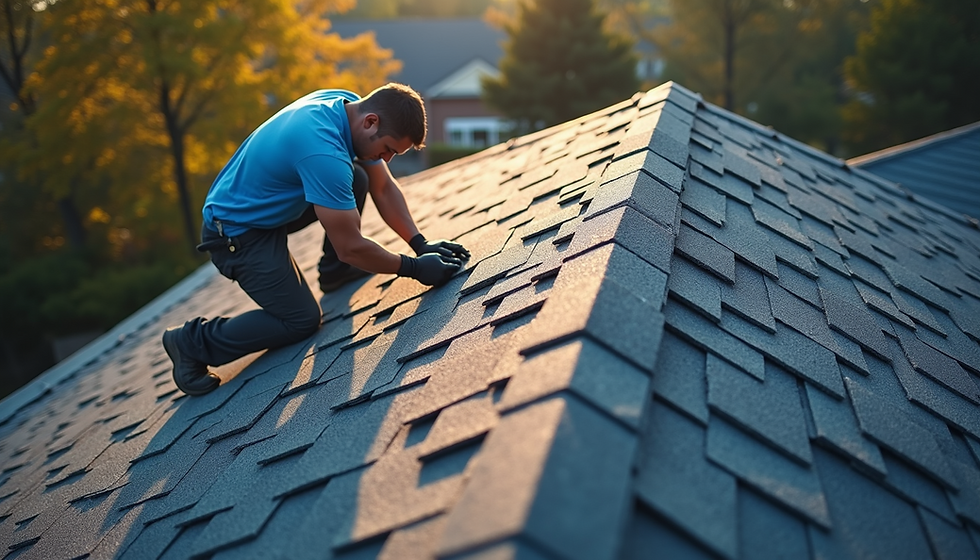Repairing Roof Damage: Step-by-Step Solutions
- James Creed
- Oct 24
- 3 min read
When your roof sustains damage, it can lead to leaks, structural issues, and costly repairs if not addressed promptly. Understanding how to identify, assess, and fix roof damage is essential for maintaining the safety and integrity of your home. This guide provides clear, practical steps to help you navigate the process of roof damage repair efficiently.
Identifying Common Types of Roof Damage
Before you begin any repair work, it is crucial to identify the type of damage your roof has sustained. Common roof issues include:
Missing or broken shingles: Often caused by strong winds or storms.
Leaks and water damage: Signs include water stains on ceilings or walls.
Cracked or damaged flashing: Flashing seals roof joints and prevents water intrusion.
Sagging roof deck: Indicates structural damage or water accumulation.
Granule loss on shingles: Reduces the roof’s ability to protect against UV rays.
Inspect your roof carefully after severe weather events. Use binoculars for a close-up view if climbing onto the roof is unsafe. Look for curled, cracked, or missing shingles, and check gutters for shingle granules.

Essential Steps for Roof Damage Repair
Once you have identified the damage, follow these step-by-step solutions to repair your roof effectively:
1. Safety First
Always prioritize safety. Use a sturdy ladder, wear non-slip shoes, and consider using a harness if the roof is steep. Avoid working on the roof during wet or windy conditions.
2. Gather Necessary Tools and Materials
Typical tools and materials include:
Replacement shingles or roofing material
Roofing nails and hammer or nail gun
Roofing cement or sealant
Pry bar for removing damaged shingles
Utility knife
Ladder and safety gear
3. Remove Damaged Shingles
Carefully lift the edges of the surrounding shingles using a pry bar. Remove nails from the damaged shingles and slide them out. Be gentle to avoid damaging adjacent shingles.
4. Install New Shingles
Slide the new shingles into place, aligning them with the existing ones. Nail them securely, ensuring nails are placed just above the shingle tab and not exposed. Apply roofing cement under the edges to seal them.
5. Repair Flashing and Seal Leaks
Inspect flashing around chimneys, vents, and skylights. Replace or reseal damaged flashing with roofing cement. For small leaks, apply roofing sealant directly to the affected area.
6. Clean Up and Inspect
Remove all debris from the roof and gutters. Conduct a final inspection to ensure all repairs are secure and watertight.

How much does it typically cost to patch a roof?
The cost to patch a roof varies depending on the extent of the damage, materials used, and labor costs in your area. On average:
Minor repairs (replacing a few shingles or sealing small leaks) can cost between $150 and $400.
Moderate repairs involving flashing replacement or patching larger areas may range from $400 to $1,000.
Extensive repairs or partial roof replacements can exceed $1,000.
Keep in mind that DIY repairs can save money but may not be suitable for all situations, especially if the damage is extensive or the roof is difficult to access. Hiring a professional ensures the job is done safely and correctly.

Tips for Preventing Future Roof Damage
Preventing roof damage is just as important as repairing it. Here are some practical tips to extend the life of your roof:
Regular inspections: Schedule roof inspections at least twice a year and after major storms.
Clean gutters: Ensure gutters and downspouts are free of debris to prevent water backup.
Trim overhanging branches: Prevent branches from rubbing against or falling on the roof.
Maintain attic ventilation: Proper ventilation reduces heat and moisture buildup that can damage roofing materials.
Address minor issues promptly: Fix small problems before they escalate into major repairs.
By following these preventive measures, you can reduce the likelihood of costly roof damage and maintain your home’s protection.
When to Call a Professional for Roof Damage Repair
While many minor repairs can be handled by homeowners, some situations require professional expertise:
Extensive damage covering large areas
Structural issues such as sagging or rot
Complex roof designs or steep slopes
Persistent leaks despite repairs
Lack of proper tools or safety equipment
If you are unsure about the extent of the damage or your ability to safely complete repairs, it is wise to consult a roofing professional. They can provide a thorough assessment and recommend the best course of action.
For reliable and expert assistance, consider contacting a trusted service to repair roof damage efficiently and safely.
By understanding the types of roof damage, following clear repair steps, and knowing when to seek professional help, you can protect your home and avoid costly repairs in the future. Regular maintenance and timely repairs are key to a durable, weather-resistant roof.




Comments